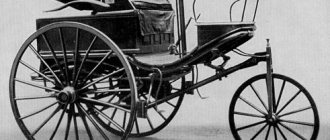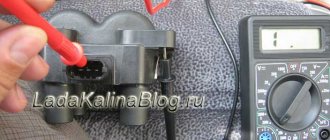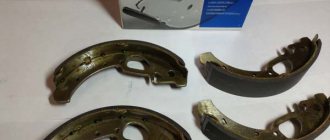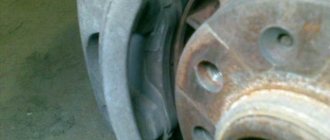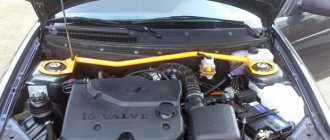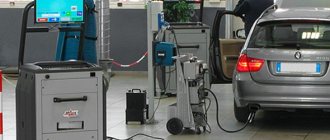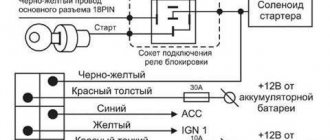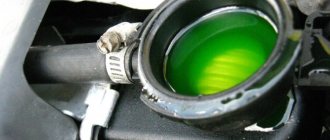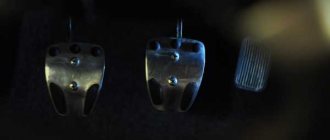checking and adjusting brakes on VAZ 2110 VAZ 2111 VAZ 2112 cars
Checking pipelines and connections To prevent sudden failure of the brake system of the VAZ 2110, VAZ 2111, VAZ 2112, carefully check the condition of all pipelines and connections, paying attention to the following: metal pipelines should not have nicks, scratches, burrs, active foci of corrosion and should be located away from from sharp edges that can damage them;
brake hoses must not have any cracks on the outer shell or signs of chafing visible to the naked eye; they should not be exposed to mineral oils and lubricants that dissolve rubber; by pressing the brake pedal firmly, check to see if any swelling appears on the hoses, indicating their destruction; all pipeline fastening brackets must be intact and well secured; loosening or destruction of brackets leads to vibration of pipelines, causing their breakdowns; Do not allow fluid to leak from the connections of the master cylinder with the tank and pipelines; if necessary, replace the tank bushings and tighten the nuts without subjecting the pipelines to deformation. When tightening the pipeline nuts, use the wrench 67.7812.9525. Eliminate any detected faults by replacing damaged parts with new ones. Flexible hoses, regardless of their condition, should be replaced with new ones after 125 thousand kilometers or after five years of operation of a VAZ 2110, VAZ 2111, VAZ 2112 to prevent sudden ruptures due to aging.
Checking the functionality of the vacuum booster VAZ 2110, VAZ 2111, VAZ 2112
Press the brake pedal 5-6 times with the engine off to create equal pressure close to atmospheric in cavities A and B (see Fig. 6-2). At the same time, by the force applied to the pedal, make sure that the valve body is not jammed. Keep the brake pedal depressed and start the engine. If the vacuum booster of the VAZ 2110, VAZ 2111, VAZ 2112 is in good working order, the brake pedal should “move forward” after starting the engine. If the brake pedal does not “go forward”, check the fastening of the hose tip, the condition and fastening of the tip flange in the booster, the hose to the tip and the fitting of the engine intake pipe, since loosening the fastening or their damage sharply reduces the vacuum in cavity A and the efficiency of the booster.
rice.
6-2. Vacuum booster: 1 - vacuum booster housing; 2 — amplifier housing cup; 3 - rod; 4 — adjusting bolt; 5 — rod seal; 6 — sealing ring of the main cylinder flange 7 — diaphragm return spring; 8 — amplifier pin; 9 — tip mounting flange; 10 - valve; 11 — hose tip; 12 - diaphragm; 13 — amplifier housing cover; 14 — sealing cover; 15 - piston; 16 — protective cover of the valve body; 17 — air filter; 18 — pusher; 19 — pusher return spring; 20 — valve spring; 21 - valve; 22 — valve body bushing; 23 — rod buffer; 24 — valve body; A - vacuum chamber; B - atmospheric chamber; C, D - channels Adjusting the brake drive of VAZ 2110, VAZ 2111, VAZ 2112
The free play of the brake pedal when the engine is not running should be 3-5 mm. The adjustment is carried out by moving the brake light switch 7 (Fig. 6-11) with nut 6 released. Install the switch so that its buffer rests against the pedal stop, and the free play of the pedal is 3-5 mm. In this position of the switch, tighten nut 6.
rice.
6-11. Brake drive: 1 — master cylinder; 2 - tank; 3 - vacuum booster; 4 — brake pedal bracket; 5 — brake light switch buffer; 6 — brake light mounting nut; 7 — brake light switch; 8 - brake pedal WARNING Adjust the free play of the brake pedal when the engine of the VAZ 2110, VAZ 2111, VAZ 2112 is not running. If the brake light switch is too close to the pedal, it does not return to its original position.
In this case, valve 21 (see Fig. 6-2), pressing against body 24, separates cavities A and B, which opens air access to chamber B, and the wheels are incompletely released when the pedal is released. If moving the brake light switch cannot eliminate the incomplete release of the brake mechanisms, then disconnect the brake master cylinder from the vacuum booster and check the protrusion of the adjusting bolt 4 relative to the mounting plane of the master cylinder flange (size 1.25-0.2 mm). This size can be set by holding the end of the rod with a special wrench, and with another wrench, tightening or unscrewing bolt 4.
Adjustment video:
What is done
the pads have been changed, all the springs have been changed, the rear brake cylinders have been changed, the guide pins have been changed along with the boots on the front brake calipers and coated with graphite grease, everything under the drum has been amazingly cleaned) the sorcerer (brake force regulator) has been adjusted, the brake fluid has been changed
Reasons for replacement
the ass didn't slow down, the rear cylinders were leaking, the pads were almost dead, they were shorter than puss =)
Key Points
don’t forget to lower the handbrake if you get into the drums =) and loosen it to the roots, don’t crumble the drum! because he is fragile. even cast iron (like mine) can be crumbled. when I knocked them down I used a rubber mallet. If you don’t have one, a block will help! don’t wear the anthers on your fingers upside down =)) don’t forget to buy a cotter pin at the store. Because of this little thing, work can stop. if the new pads do not come together completely, thereby preventing the drum from getting dressed, then read below.
If the drum doesn't fit
then you need to grind down the small seat on the boat for the spacer bar between the pads or sharpen the bar itself (I chose this option, the photo shows how much I ground) loosen the broken handbrake and pull out the cable
How I regulated the sorcerer
The car must stand on 4 wheels. We open the trunk and sit down on this bar in front of our eyes and jump. to sag the suspension. We climb under the car and find the sorcerer. We spray it everywhere with a stick or a brake pad to make it easier to move. Loosen the bolt by 13. Take a pre-purchased 2mm drill and set the gap (you can by eye). Tighten the bolt by 13. That is. The smaller the gap, the sooner the ass will slow down. If the gap is 0, then you can fly away in winter))) It is necessary to adjust the sorcerer if something has been done to the suspension, because he “casts a spell” looking at the beam.
How to properly bleed your brakes!
many shake it like this: first the ass, then the face. BUT IT'S NOT RIGHT! because The braking system is two-circuit, diagonal (maybe I almost said it wrong, but the gist is this =) you need to pump it like this: first the rear right cylinder, then the front left one, then the rear left one, then the front right cylinder! I did this probably 3 times =)) a little shorter) and the car sat overnight with the brake fluid leaking out.
what troubles there were =)
when I unscrewed the right rear goods tube from the cylinder, it began to spin and broke. and it didn’t unscrew from the hose, so I changed this accordingly) By the way, if you buy a new tube, don’t be bothered if you have to adjust it in place =)) I probably spent about 20 minutes on this!
without jambs anywhere =)
after the replacement, the ass slows down, bless you) but a problem arose - the handbrake is missing.
I cut the springs - there is an effect, but it’s too small! It turns out I put it together a little wrong. The photo shows that the hook that clings to the cable should be along the block, but in the photo it is incorrect. all because when I loosened the handbrake, I still had to pull out the cables, but I didn’t know this and that’s how it happened =) thanks to Andryukha NoFeaR-33 helped sort out the problem)
our correspondence on this matter is visible in the comments. When I set everything up as it should, I wanted to take a photo so it would be clearer, but it turns out the flash drive from the camera was left at home.
DO YOU HAVE ANY QUESTIONS? Ask if anything is unclear
The free play of the brake pedal when the engine is not running should be 3-5 mm. The adjustment is carried out by moving the brake light switch with nut 6 released. Install the switch so that its buffer rests against the pedal stop, and the free play of the pedal is 3-5 mm. With the switch in this position, tighten the nut.
Adjust the free play of the brake pedal when the engine of the VAZ 2110, VAZ 2111, VAZ 2112 is not running. If the brake light switch is too close to the pedal, it does not return to its original position. In this case, the valve, pressing against the body, separates cavities A and B, which opens air access to chamber B, and the wheels are incompletely released when the pedal is released.
If moving the brake light switch cannot eliminate incomplete release of the brake mechanisms, then disconnect the brake master cylinder from the vacuum booster and check the protrusion of the adjusting bolt relative to the mounting plane of the master cylinder flange (size 1.25-0.2 mm). This size can be set by holding the end of the rod with a special wrench and using another wrench to tighten or unscrew the bolt.
Read more: Check fine by VIN code
Brake drive:
1 - main cylinder; 2 - tank; 3 - vacuum booster; 4 — brake pedal bracket;
5 — brake light switch buffer; 6 — brake light mounting nut;
7 — brake light switch; 8 — brake pedal
If the parking brake system does not hold the VAZ 2110-2112 car on a 25% slope when moving the lever 2-8 teeth of the sector, adjust the system in the following order:
· loosen the lock nut of the tension device and tighten the cable by tightening the adjusting nut 6;
· check the full stroke of the lever, which should be 2-4 teeth per sector, then tighten the locknut.
After performing several brakes, make sure that the stroke of the lever has not changed and the wheels rotate freely, without sticking when the lever is completely lowered.
Parking brake system drive:
1 — lever fixation button; 2 — parking brake drive lever; 3 — protective cover;
4 - traction; 5 — cable equalizer; 6 — adjusting nut; 7 - lock nut; 8 - cable; 9 — cable sheath
Checking pipelines and connections
Place the VAZ 2110 car on a lift or inspection ditch, clean the pressure regulator and its drive parts from dirt. By external inspection, make sure that the pressure regulator and its drive parts are not damaged, there is no leakage of brake fluid, the plug is recessed into the housing hole by 1-2 mm, and there is no play in the connection of the earring with the elastic lever and the bracket pin. Have an assistant press the brake pedal. In this case, the piston should extend from the housing by 1.6-2.4 mm, compressing the leaf spring until it stops against the lever. The lever, overcoming the force from the elastic lever, will rotate relative to the pin. Non-compliance with the listed requirements, lack of piston stroke, as well as its insufficient or excessive stroke indicates a malfunction of the regulator or its drive. In this case, repair or replace the pressure regulator, and after installing it, adjust its drive.
1 — pressure regulator housing; 2 - piston; 3 — protective cap; 4, 8 — retaining rings; 5 — piston sleeve; 6 — piston spring; 7 — body bushing; 9, 22 — support washers; 10 — sealing rings of the pusher; 11 — support plate; 12 — pusher bushing spring; 13 — sealing ring of the valve seat; 14 — valve seat; 15 - sealing gasket; 16 - plug; 17 — valve spring; 18 - valve; 19 — pusher bushing; 20 — pusher; 21 — piston head seal; 23 — piston rod seal; 24 - plug; A, O - chambers connected to the main cylinder; B, C - chambers connected to the wheel cylinders of the rear brakes; K, M, N - gaps
Removing air from the hydraulic drive
Bleeding the brakes on cars of the VAZ 2110 family is necessary to remove air from the hydraulic drive, which significantly reduces the effectiveness of the service brake system. Air can enter the hydraulic drive due to depressurization of the system during repair or replacement of individual components, as well as when replacing brake fluid. The presence of air in the brake drive is indicated by increased travel of the brake pedal and its “softness”. Before removing air from the brake system, make sure that all brake drive units and their connections are tight, clean the cover and the surface around the reservoir cover, fill the reservoir with Rosa fluid up to the “MAX” mark with the cover removed. Then thoroughly clean the bleeder fittings and remove their protective caps. Note.
It is not recommended to use brake fluid drained from the system to fill the reservoir, as it is saturated with air, moisture and possibly contaminated.
Air from the brake system of VAZ 2110, VAZ 2111, VAZ 2112 cars is removed first from one circuit, then from the other, starting with the wheel cylinders of the rear brakes. Place a rubber hose onto the head of the fitting to drain the liquid, and lower its free end into a transparent container partially filled with liquid. Pressing the brake pedal sharply 3-5 times at intervals of 2-3 seconds, unscrew the fitting 1/2-3/4 turn with the pedal pressed. Continuing to press the pedal, displace the liquid in the system along with the air through the hose into the container. After the brake pedal reaches the forward extreme position and the flow of fluid through the hose stops, tighten the air bleeder fitting as far as it will go. Repeat these operations until bubbles stop coming out of the hose. Keeping the pedal pressed, tighten the fitting as far as it will go and remove the hose. Wipe the fitting dry and put on the protective cap. Repeat the operations for other wheels, first on the second wheel of the same circuit, and then sequentially on both wheels of the other circuit. When removing air, make sure that there is liquid in the tank, avoiding exposing its bottom, as this will allow air to enter the system again. If there is no air in the brake drive, the brake pedal should go through 1/2 of its full travel. To eliminate the influence of the vacuum booster on bleeding the brakes, remove air with the engine not running. If there is no brake fluid in the hydraulic drive, fill the system as follows: pour brake fluid into the master cylinder reservoir; unscrew the fittings on the cylinders of all wheels by 1.5-2 turns; pressing the brake pedal sharply and releasing it smoothly, tighten the fittings as fluid flows out of them. Then bleed the system. When removing air on car models VAZ 2110, VAZ 2111 and VAZ 2112, the brake system of which has been in operation for a long time, replace the fluid in the system with a new one.
Replacing brake fluid
To ensure that no air gets into the hydraulic drive system when replacing the brake fluid, and to spend a minimum amount of time on this operation, adhere to the following rules:
Read more: How much is given to pay a fine?
· proceed in the same order as when bleeding the brakes, but use a hose with a glass tube at the end, which is lowered into a container with brake fluid;
· while pressing the brake pedal, pump out the old brake fluid until new fluid appears in the tube;
· then make two full strokes with the brake pedal and, holding it pressed, tighten the fitting. When pumping, monitor the fluid level in the tank and promptly add fluid to the maximum level;
· repeat the same operation on each working cylinder in the same order as when bleeding;
· fill the reservoir to the maximum level and check the operation of the brakes while the car is moving.
Removing and installing a vacuum booster on VAZ 2110 cars
When removing the vacuum booster, the main cylinder of the hydraulic brake drive is not disconnected from the hydraulic system so that air does not get into it.
The procedure for removing the vacuum booster:
· unscrew the nuts securing the master cylinder to the amplifier, remove it from the studs and move it to the side, carefully bending the pipelines so as not to damage them;
· disconnect the hose from the amplifier;
· unscrew the nuts securing the brake pedal bracket to the body and remove the bracket assembly with the vacuum booster and pedal. Then disconnect the vacuum booster from the pedal by removing the bracket and removing the pin. Remove the vacuum booster from the bracket.
Install the vacuum booster in the reverse order. Disassembling the vacuum amplifier of a VAZ 2110 car is not allowed.
Vacuum booster and master cylinder mounting parts:
1 - main cylinder; 2 — master cylinder reservoir; 3 - vacuum booster; 4 — brake pedal bracket; 5 - finger; 6 — locking bracket; 7 — brake pedal
Master brake cylinder VAZ 2110
Removal and installation of the main brake cylinder from cars of the VAZ 2110 family.
Withdrawal. Disconnect the pipelines from the master cylinder and the block with wires from the emergency brake fluid level sensor terminals. Close the openings at the pipelines and at the master cylinder to prevent fluid leakage and dust and dirt from entering them. Remove the cylinder assembly with the tank by unscrewing the nuts securing it to the vacuum booster. Remove the emergency brake fluid level sensor and drain the brake fluid from the reservoir and cylinder. It is not recommended to remove the reservoir from the master cylinder unless necessary. Install the master brake cylinder in the reverse order of removal. After installing the cylinder, bleed the brake hydraulic system to remove air.
Brake mechanism of the front wheel of a VAZ 2110 car
Removing and installing the front wheel brake mechanism on VAZ 2110 cars.
Withdrawal. Lift the front part of the VAZ 2110, VAZ 2111, VAZ 2112, place it on stands and remove the wheel. Unscrew the pipeline fitting and disconnect the flexible hose from the line; Plug the holes in the hose and tube to prevent brake fluid from leaking. Remove the hose from the guide bracket. After unscrewing the two bolts that secure the guide block to the steering knuckle, remove the guide assembly with the caliper and working cylinder.
Installation of the brake mechanism is carried out in the reverse order of removal. After installation, restore the brake fluid level in the reservoir and bleed the hydraulic drive system to remove air.
Checking the brake disc runout
Check the axial runout of the working surface of the brake disc; without removing it from the car. The maximum permissible runout according to the indicator is 0.15 mm. If the runout is greater, replace the disc or grind it, but the final disc thickness must be at least 17.8 mm.
Checking the axial runout of the brake disc: 1 - indicator; 2 - brake disc
Replacing brake pads
If it is necessary to replace the brake pads, bend the corner of the lock washer from the edge of the lower bolt, unscrew it, holding the guide pin by the edge with a wrench, and disconnect the pad wear indicator from the split pad. Then rotate the caliper and cylinder assembly relative to the other pin, remove the brake pad from the piston side and lower the caliper to the working position. Careful not to damage the dust cap and to prevent brake fluid from splashing out of the master cylinder reservoir, move the piston as far inside the cylinder as possible, pushing off the surface of the brake disc with a screwdriver. With the caliper raised, replace the worn outer pad with a new one and lower the caliper to the running position. Move the piston inside the cylinder again and, lifting the caliper, replace the inner brake pad. Having lowered the caliper, tighten and lock the bolt, the threads of which have a coating that prevents the guide pin from loosening itself.
If the fluid level in the master cylinder reservoir is close to or equal to 0, remove some of the liquid from the reservoir before retracting the piston to prevent it from splashing out of the reservoir.
When replacing brake pads on VAZ 2110, VAZ 2111, VAZ 2112 vehicles, check the condition and fit of the piston protective caps and guide pin covers in the sockets. Replace them if necessary or ensure proper seating in the sockets.
Replacing brake pads:
A - viewing window; 1 — caliper; 2 - fitting; 3 - cap; 4 - hose; 5 — wheel cylinder; 6 - bolt; 7 — lock washer; 8 — brake disc; 9 — brake pads; 10 — pad guide; 11 — protective casing of the brake disc; 12 — protective cover; 13 - guide pin
Brake mechanism of the rear wheel of a VAZ 2110 car
1 - guide pin; 2 — brake drum; A - threaded hole used to remove the drum
Rear wheel brake parts:
1 — brake shield; 2 — wheel cylinder; 3 — upper tension spring of the pads; 4 — brake pad; 5 — pad lining; 6 — brake drum; 7—locating pin; 8 — guide spring; 9 - lower tension spring
Read more: Four-wheel drive how to drive
Rear wheel brake:
1 — hub fastening nut; 2 — wheel hub; 3 — lower tension spring of the pads; 4 — brake pad; 5 — guide spring; 6 — wheel cylinder; 7 — upper tension spring; 8 — expansion bar; 9 — finger of the parking brake drive lever; 10 — parking brake drive lever; 11 — brake shield
Removing and installing the rear wheel brake mechanism on VAZ 2110 cars
Withdrawal. Lift the rear of the VAZ car and remove the wheel. Remove the brake drum by unscrewing the guide pins and then screwing them into the threaded holes A until the drum separates. After loosening the parking brake system drive cable, disconnect the cable end from the lever, remove the cotter pin, press the pin and remove the lever. Remove the pad guide springs, disconnect the upper and lower pad tension springs, and remove the pads. Having taken measures to prevent fluid from leaking from the master cylinder, disconnect the brake fluid supply tube from the wheel cylinder and plug the inlet holes of the cylinder and tube. Remove the wheel cylinder. When replacing the brake shield, unscrew the bolts securing it to the rear wheel axle flange and remove the shield.
Install the brake mechanism parts in the reverse order of removal, taking into account the following:
· after installing the pads on the brake shield, make sure that the ends of the pads are correctly positioned in the grooves of the wheel cylinder piston stops and on the support plate;
· before installing the drum, lubricate the hub seating belt with graphite grease or CV joint-4 grease.
After assembling the brake mechanisms and removing air from the hydraulic drive, press the brake pedal 2-3 times with a force of 39.2 N (40 kgf) to set the pistons to the working position. Then check the ease of rotation of the wheel (the drum may slightly touch the pads). Adjust the parking brake system.
Checking the rear wheel brake parts
Wheel cylinders. Check the cleanliness of the working surfaces of the cylinder, pistons and thrust rings. The surfaces must be completely smooth to prevent fluid leakage and premature wear of seals and pistons. Eliminate defects on the cylinder surface by lapping or grinding. However, an increase in the internal diameter of the cylinder is not allowed. Check the condition of the thrust screw 3 (see Fig. 6-28), spring 6, support cup 7 and nuts 5. If necessary, replace damaged parts with new ones. Replace the seals 8 with new ones. Check the condition of the protective caps 10 and replace them if necessary.
Pads. Carefully check the pads for damage or deformation. Check the elasticity of the coupling and guide springs of the pads, if necessary, replace them with new ones. The tension springs must not have residual deformations when the lower springs are stretched with a force of 137.2 N (14 kgf) and the upper springs with a force of 294 N (30 kgf). Check the cleanliness of the linings, if dirt or traces of grease are found, thoroughly clean the linings with a wire brush and rinse with white spirit, in addition, check for any lubricant leakage inside the drum; Eliminate any detected faults. Replace the pads with new ones if the thickness of the linings becomes less than 1.5 mm. Carry out the replacement at the same time on both brake mechanisms, that is, replace both pairs of pads.
Brake drums. Inspect the brake drums. If there are deep grooves or excessive ovality on the working surface, then bore the drums on the machine. Then, also on the machine, grind the drums with fine-grained abrasive stones. This increases the durability of the linings and improves uniformity and braking performance. An increase in the diameter of the drum (200 mm) after boring and grinding is allowed up to 201 mm. The maximum permissible drum diameter is 201.5 mm. These requirements must be strictly observed, otherwise the strength of the drum as well as the braking efficiency will be compromised.
Parking brake system of VAZ 2110 cars
Removal and installation of the parking brake system of the VAZ 2110
Withdrawal. Set the lever to its lowest position, disconnect the cable ends from the levers of the manual drive of the shoes and from the equalizer, to do this, unscrew the lock nut and the adjusting nut from the rod, then remove the washer and equalizer. After removing the cotter pin and axle, remove the washer, lever and pad release bar. Unscrew the nuts securing the lever bracket to the body floor and remove it complete with the bracket.
Install the parts of the parking brake system of the VAZ 2110, VAZ 2111, VAZ 2112 in the reverse order of removal, followed by its adjustment. When installing, coat the parking brake lever axis, front and rear cable ends, and the rod connecting pin with Litol-24 grease.
Checking the parts of the parking brake system of the VAZ 2110
Carefully check the condition of the parking brake system parts. If a break, chafing of the cable wires, poor fastening of the tips on it or damage to the sheath are detected, replace the cable with a new one. Make sure that the sector teeth and latch are not damaged and that the lever locks securely in position and moves up and down easily. Replace damaged and worn parts.
Parking brake system parts:
1 — parking brake drive lever assembly with bracket; 2 — thrust axis; 3 — washer; 4 - sealing ring; 5 - traction; 6 — protective cover; 7 — cable equalizer; 8 — washer; 9 — adjusting nut; 10 - lock nut; 11 - cable; 12 — cable sheath; 13 — pad expansion bar; 14 — lever axis; 15 — lever for manual drive of the pads; 16 — washer
The purpose of the sorcerer
Where is the oil pressure sensor on the Kamaz
? The so-called sorcerer on the VAZ-2109 is necessary to automatically change the fluid pressure in the rear brake cylinders depending on the load acting on the car when the speed decreases. This element is used in both hydraulic and pneumatic drive systems.
The main purpose of changing the pressure is to prevent possible wheel locking and skidding of the rear axle of the car.
In some car models, in order to maintain their controllability and stability, a regulator is additionally installed in the brake drive of the front wheels.
In addition, on the VAZ-2109 the sorcerer is used to increase the braking efficiency of an empty car. The traction force of a loaded car and an empty one is different, so the force on different axles must be adjusted. In the case of a loaded and empty machine, static type regulators are used. Automatic solutions are installed in trucks.
In sports cars, manufacturers often install a screw adjuster. It is located inside the car and adjusts the balance of the brake system directly during the race. It is adjusted based on weather conditions, road conditions, and tire quality.
How does a sorcerer work?
The regulator itself consists of a cylinder, valve, spring and rod. The latter is connected to the rear beam, which ensures the operation of the VAZ-2109 sorcerer. Also, brake fluid circuits pass through the rear brake pressure regulator. For their mounting on the device there are 4 threaded entries. How does the sorcerer regulator work on a VAZ? During emergency braking, the front of the car is pressed to the ground, and the rear is raised. This causes the regulator rod to move, which blocks the flow of fluid to the rear cylinders. A spring located under the valve prevents it from closing completely. Therefore, the rear mechanisms still work, but later and weaker than the front ones.
In this way, the movement trajectory is stabilized.
Basic faults and brake repair options
KamAZ GTK for cab
The best fix is prevention. When operating the VAZ 2108, it is necessary to strictly adhere to the scheduled maintenance periods for the brake system. This applies to the friction linings of the front disc and rear drum brakes. Complete wear of the friction linings threatens unexpected brake failure in an extreme situation. Periodically check the condition of the linings, monitor their level of wear, and replace if necessary.
Carefully monitor the brakes of the VAZ 2108 in terms of fluid leakage through worn gaskets and seals. Excessive wear of the sealing elements is fraught with the risk of insufficient force in the brake cylinders, failure of the pedal when driving the VAZ 2108, and an increase in the braking distance. All this creates very serious risks. Brakes are a critical safety system for drivers, passengers and other road users.
How to check and adjust
Brake cleaner
If during the braking process the car slows down ineffectively, the car is pulled in one direction, the car often skids, then this is a signal that you need to check the unit and adjust the sorcerer on the VAZ-2109.
To check, the car is driven into a pit or overpass. Defects will be detected visually. Most often, the inspection shows that repair is not possible.
If we talk about adjustment, it is better to do it on an overpass. The adjustment greatly depends on the position of the body. Adjustments must be made after each maintenance. Adjustment is also necessary if something from the suspension has been changed. If there has been repair work on the rear beam or it has been changed, this also requires adjustment.
To adjust the device, use a wrench to slightly loosen the bolt securing the sorcerer to the lever. Then use a screwdriver to move the bracket until the gap allows you to insert a drill into it two millimeters. Next, the bolt needs to be tightened.
The regulator on the “ten” and previous models becomes very sour during the operation of the car. The bracket cannot be moved. In this situation, you can douse it with WD-40, and then use a hammer to move the part to the side.
VAZ 2115 Checking and adjusting brakes
6.3.1 Checking and adjusting the brakes
Checking pipelines and connections Checking the functionality of the vacuum booster Adjusting the brake drive Adjusting the parking brake system Checking the functionality of the pressure regulator on the car Removing air from the hydraulic drive Replacing brake fluid
6.3.2 Checking piping and connections
To prevent sudden failure of the brake system, carefully check the condition of all pipelines and connections, paying attention to the following: – metal pipelines should not have nicks, scratches, rubs, or active foci of corrosion and should be located away from sharp edges that could damage them; – brake hoses must not have any cracks visible to the naked eye..
6.3.8 Replacing brake fluid
To ensure that no air gets into the hydraulic drive system when replacing the brake fluid and that a minimum amount of time is spent on this operation, adhere to the following rules: - proceed in the same order as when bleeding the brakes, but use a hose with a glass tube at the end, which you lower into a container with brake fluid; – while pressing the brake pedal, pump out the old brake...
Service
It comes down to checking the condition of the pads, drums and discs, checking and adjusting the free play of the pedal, periodically replacing the fluid, checking the rubber part of the lines for leaks.
Checking the condition of the cuffs of the working cylinders and bleeding the system to remove air from it.
Read on the topic: What to do if there is air in the brake system.
All elements of the VAZ 2110 brakes are repairable, except for the vacuum booster and rubber parts of the lines.
The amplifier and rubber lines cannot be repaired, so if problems arise, they are replaced.
Repair of the master cylinder comes down to replacing all rubber elements (cuffs, gaskets).
It is performed when liquid leakage is detected from it. The same applies to working cylinders.
Repair of VAZ 2110 brake mechanisms includes replacing pads, discs and drums if severe wear is detected.
Without a sorcerer
Knowing what the sorcerer's job is on the VAZ-2109, it is not difficult to guess what will happen if it is absent from the brake system. And the following will happen. The car will brake with all four wheels together. The wheels are blocked sequentially - first a pair of wheels on the rear axle, and then the front ones. The risk of an accident increases, since the driver moving behind is unlikely to react in time to a sudden maneuver. A collision will be inevitable.
A sorcerer in the car is very necessary. A VAZ-2109 car without a sorcerer can be very dangerous not only for others on the road, but also for the driver himself. This car is practically uncontrollable in a skid.
Only those who know exactly and understand well what they will get in the end remove the sorcerer. This is mostly done by professional racing drivers.
But some car owners still remove the sorcerer. At the same time, there are even claims that the car began to brake faster and better. Experts say it only seems so. In fact, everything is a little different. The problem here is that in the event of sudden braking, both pairs of wheels will jam in succession.
Checking the brake pressure regulator of VAZ 2114, VAZ 2115, VAZ 2113
/ / / / / We bleed the brakes of the Lada 2113 ourselves, check the brakes of the Lada 2115, the hydraulic brakes of the VAZ 2113, VAZ 2115, VAZ 2114.
Place the Lada Samara 2 car on a lift or inspection ditch, clean the pressure regulator and its drive parts from dirt.
Pressure regulator VAZ 2114: 1 – pressure regulator body; 2 – piston; 3 – protective cap; 4, 8 – retaining rings; 5 – piston sleeve; 6 – piston spring; 7 – body bushing; 9, 22 – support washers; 10 – sealing rings of the pusher; 11 – support plate; 12 – pusher bushing spring; 13 – valve seat sealing ring; 14 – valve seat; 15 – sealing gasket; 16 – plug; 17 – valve spring; 18 – valve; 19 – pusher bushing; 20 – pusher; 21 – piston head seal; 23 – piston rod seal; 24 – plug; A, D - chambers connected to the main cylinder; B, C - chambers connected to the wheel cylinders of the rear brakes; K, M, N - gaps
Pressure regulator drive VAZ 2115: 1 – pressure regulator; 2, 16 – pressure regulator mounting bolts; 3 – bracket for the pressure regulator drive lever; 4 – pin; 5 – pressure regulator drive lever; 6 – axis of the pressure regulator drive lever; 7 – lever spring; 8 – body bracket; 9 – pressure regulator mounting bracket; 10 – elastic lever of the pressure regulator drive; 11 – earring; 12 – earring bracket; 13 – washer; 14 – retaining ring; 15 – bracket pin; A, B, C - holes
By external inspection, make sure that the pressure regulator of the Lada Samara 2 and its drive parts are not damaged, there is no leakage of brake fluid, plug 24 is recessed into the housing hole by 1–2 mm, there is no play in the connection of the earring 11 with the elastic lever 10 and the pin 15 of the bracket. Ask an assistant to press the brake pedal of the VAZ 2114, VAZ 2115, VAZ 2113. At the same time, piston 2 should move out of the body by 1.6–2.4 mm, compressing the leaf spring 7 until it stops against lever 5. Lever 5, overcoming the force with side of the elastic lever 10, will rotate relative to pin 4. Non-compliance with the listed requirements, lack of piston stroke, as well as its insufficient or excessive stroke indicate a malfunction of the regulator or its drive. In this case, repair or replace the pressure regulator, and after installing it, adjust its drive (see subsection “Adjusting the VAZ 2113 pressure regulator drive”).
- —
Checking pipelines and connections of the brake system of VAZ 2114, VAZ 2115, VAZ 2113
—
—
—
—
—
—
Replacing brake fluid
Replacing brake fluid VAZ 2114, VAZ 2115, VAZ 2113
Operation and repair of the brake system of the Lada 2113. Checking the regulator, cylinder, brake booster of the Lada 2114. Maintenance of the front and rear brake mechanisms of the Lada 2115.
Braking system design
The most important component of the VAZ 2110 brake system circuit is a vacuum booster and a dual-circuit regulator. The latter is responsible for creating pressure in the rear brake devices.
The brake drive is equipped with a piping system, which is divided into two circuits, brake devices and hoses. They allow the front and rear wheels to brake.
To activate the braking system, a special pedal is located inside the passenger compartment at the driver’s feet. In the VAZ 2110 car it is located in the middle. The main elements of the hydraulic drive are:
- Vacuum booster . Its design helps create pressure directed towards the master cylinder piston.
- Pressure regulator drive . Through it, the brake fluid is directed to the rear devices of the braking system.
- Direct brake pressure regulator VAZ 2110 . Its function is to be responsible for the force of pressure. The unit reduces or increases this indicator, depending on the load on the rear axle of the car.
- Master cylinder with reservoir and pistons . On the filler neck of this tank there is a sensor that monitors the emergency level of brake fluid.
- Front wheel brake . Its design includes cylinders, pads and a disc, plus a special alarm that warns of wear or malfunction of the lining.
- Rear wheel brake . Here the system is not disk, but drum. At least, this is the design the factory envisages. Some VAZ 2110 owners believe that drum mechanisms are not reliable and efficient enough, and therefore install disk devices in their place.
Brake force regulator device
It is mounted on a body bracket and connected on passenger cars to the rear axle beam via a rod and torsion bar. The second end of the last element acts on the regulator piston. The regulator input is connected to and the output is connected to the rear. The device is controlled by a drive connected to the rear beam. As for the design, the brake force regulator consists of a housing divided into several cavities (usually two). One of them is connected to the main cylinder, the other to the rear system. There are also pistons and valves that block access
When work starts, the pressure in the two chambers is the same. However, in the first, the liquid acts on a smaller area of the piston, while in the second, on a larger area. The piston strives to move, but cannot do this due to the centering spring. If the pressure in the master cylinder begins to increase, then the piston can easily overcome the force of the spring, causing the valve to block the flow of fluid. This is the classic principle of operation of the brake force regulator. Today there are hydraulic elements, pneumatic, and electronically controlled.
Operation of the pneumatic modulator
Let us consider in detail the operation of a pneumatic modulator made on the basis of an accelerator valve (Fig. a). Compressed air from the brake valve enters through the line into cavity A and then passes through cavity B into cavity C and presses down on the follower piston 4. The piston moves down and rests against valve 5, disconnecting cavity G from the outlet to the atmosphere. Further downward movement of the piston leads to the opening of valve 5.
As a result, compressed air begins to pass from the receiver through cavities D and D into the brake chambers.
If the braking wheel begins to lock, the electronic unit simultaneously sends control signals to electromagnets 2 and 3, which close valve 1 and open valve 6. In this case, cavities B and C are connected to the atmosphere - the wheel is automatically released. At some angular acceleration of the wheel, the electronic unit removes the electrical voltage from electromagnet 3. As a result, valve 6 closes again under the action of a spring and the holding phase begins.
The phase of repeated automatic braking of the wheel occurs when the wheel acquires a threshold angular acceleration. In this case, the electronic unit removes the electrical voltage from electromagnet 2, which allows valve 1 to open and connect working cavity B to the main line. Then the cycle repeats.
Typical faults
There are very few malfunctions that occur in this part. These include stuck valves, misalignment, and leaks.
If the sorcerer is upset, he can be adjusted. And they determine whether adjustment is needed by the behavior of the car. If the setting is off, then when braking the car will throw from side to side. If the valves are stuck or the brake fluid is leaking, the part needs to be replaced. Theoretically, repairs are possible, but the complexity and cost make it unprofitable.
The regulator may fail to operate only in two cases - at the maximum possible load and at a speed limit above 80 kilometers per hour. In this situation, the speed does not drop quickly, so the rear axle is not unloaded.
How does the brake force regulator work during braking?
When the driver sharply presses the pedal, the rear part of the body will rise, and the front, on the contrary, will lower. And at this moment the brake force regulator begins its work. Once the device is running, it will immediately allow the rear wheels to begin to reduce speed immediately after pressing the pedal. The fact is that if the wheels on the rear axle of the car begin braking at the same moment as the front axle, then there is a high probability of skidding.
If the wheels on the rear axle begin to slow down later than the front ones, then the risk of skidding is reduced to almost zero. When the car slows down, the distance between the bottom and the rear beam increases at the rear. While this gap grows, the lever releases the regulator piston and, thanks to this, the fluid line that goes to the rear wheels is blocked. As a result, they will not lock, but will continue to rotate.
Device
The VAZ-2110 brake system consists of a master cylinder with an installed fluid reservoir, from which the lines of two circuits emerge.
The schematic diagram is shown below.
One circuit interacts with the mechanisms of the front right and rear left wheels, the second - vice versa, hence the diagonal system.
Between the pedal and the cylinder there is a non-separable vacuum booster.
The front wheel lines of both circuits, coming out of the main cylinder, go directly to the working cylinders of the calipers.
The lines going to the rear mechanisms are first connected to the pressure regulator, and then from it to the mechanisms themselves.
This regulator is designed to adjust the fluid pressure in the lines at different loads on the rear axle.
Replacing the sorcerer with a VAZ 2114 tee
Among some car enthusiasts, such a technical procedure as replacing the standard brake force regulator with a so-called tee is popular. The reasons for this replacement are constant complaints from car owners about problems with the sorcerer, for example: - Initially incorrect operation of the new product; - For souring of the element. As a result, failure or improper operation of the braking system; - Other problems.
In other words, driving with a faulty sorcerer is fraught with consequences in the form of skidding, which at high speeds can lead to serious accidents and overturning of the car. Conversely, driving without a brake force regulator is safer (compared to a faulty regulator) due to the fact that only two front wheels are involved in braking, the rear wheels are not blocked at all.
Some car owners simply get rid of the sorcerer. In this case, only the front wheels are used for braking. Other car enthusiasts install a tee instead of the sorcerer VAZ 2114. The tee ensures simultaneous blocking and, accordingly, uniform distribution of braking forces between four wheels. This approach has its pros and cons.
Here's the diagram
Disadvantages of using a tee: — Uncomfortable and dangerous braking in winter conditions (icy conditions); — Possibility of skidding (in cases where the rear wheels lock faster than the front wheels).
Pros: — Sharper and more responsive brakes; — Lower cost of the part; — Increased service life.
Both cars and trucks consist of many components. One important component is the brake force regulator. Not all motorists know how this element works and works. But if it is faulty, an unpleasant surprise may occur for the driver during emergency braking. Car owners call this component of the braking system the “sorcerer”. This node received this name because its work was very mysterious and unpredictable. Let's try to understand the structure, operating principle and adjustment of this regulator.
The feasibility of installing a vacuum brake booster
The vacuum booster dramatically improves the driving comfort of the VAZ 2108. It reduces the pedal effort required to stop the car. All modern cars are equipped with a vacuum booster. Domestic and imported. Nowadays, it is impossible to imagine a car without a vacuum brake booster.
The amplifier is aggregated with the master brake cylinder and is mounted on a shield separating the engine compartment from the interior of the VAZ 2108. It is connected to the engine crankcase with a flexible hose to supply rarefied air necessary for the operation of the amplifier. A malfunction of the amplifier is clearly indicated by a noticeable increase in the force on the brake pedal. Braking acceleration decreases.
Continuing your trip with a broken amplifier is very risky.
You can drive to the nearest car service center with caution. A cracked hose can be wrapped with several layers of electrical tape.
If replacing the cracked hose and check valve does not produce results, the unit must be replaced.
Work on removing the amplifier is carried out in this order.
- Disconnect the negative battery terminal. De-energize the electrical system.
- Disconnect the wiring block from the hydraulic reservoir cap located on the brake master cylinder body.
- From the passenger compartment, remove the amplifier pusher pin using pliers. Disconnect the pusher.
- Disconnect the hose going to the engine crankcase.
- Unscrew the two nuts securing the brake master cylinder.
- Move the cylinder away from the amplifier housing. Leave it hanging from the metal hydraulic pipes.
- Unscrew the four nuts securing the amplifier bracket to the engine shield and carefully remove the amplifier.
- Unscrew the two nuts securing the amplifier to the bracket. Disconnect the bracket and amplifier.
Install the new VAZ 2108 vacuum booster in the reverse order.
Improvement of the braking system
Many VAZ 2110 owners agree that the factory brake system is far from perfect. Therefore, they decide to modernize and improve the unit using technical tuning.
A popular solution to the issue of brake efficiency is to replace drum mechanisms with disc ones. Of course, in the case of the “ten” we are talking about the rear wheels. When replacing brakes, be sure to take into account the fact that the rear wheels must brake more softly and somewhat later than the front wheels. This way the car won't skid and you won't fly off the road.
Another option is to remove the factory brake master cylinder and vacuum booster. Instead, units from Priora are excellent. Such tuning will eliminate vibrations and also allow you to use the brake pedal effectively and without excessive effort.
Regardless of the changes made to the brake system, after each modification it is mandatory to pump the brakes.
Replacing the sorcerer on a VAZ 2114
Dismantling and reinstalling a non-working device does not cause significant problems and is accessible to almost anyone. The automaker recommends replacing the faulty regulator assembly. To carry out the work you will need:
- flat screwdriver;
- key to 13;
- 10mm socket for removing brake pipes.
The replacement sequence is as follows:
- We provide convenient access to the rear of the car's underbody (we use a lift, pit, or overpass).
- We find the regulator drive lever. We lift the bracket up and release it. If difficulties arise, use a screwdriver to slightly release the bracket.
- Remove the earring bracket.
- Now we disconnect the four tubes from the body of the product. To do this, you need to loosen and unscrew the fastening nuts. To prevent brake fluid from leaking, plug (seal) the holes of all pipes. In the future, in order not to confuse the connections to the regulator, we mark the 4 pipes with different colors or numbers.
- We unscrew the front bolt of the sorcerer (with which it is attached to the bracket).
- From the side of the bracket, unscrew another bolt.
- Remove the complete device (together with the drive).
- After replacing the product, installation is carried out in the reverse order.
Please note that after reinstallation, the earring fastening bracket must be crimped with pliers. In addition, it is necessary to bleed the brake system and adjust the device for proper operation.
Approximate sequence of steps for pumping brakes on a VAZ-2112
The car itself is placed on an overpass or in a pit. Pumping is carried out “diagonally”, starting from the rear wheels. Example: first the rear right cylinder, then the front left one, etc.
Rear and front brake cylinder
There is a fitting on each brake cylinder. We clean it, then remove the plug-cap. This will allow you to put the tube on top (see photo).
Photo 1 shows the rear brake cylinder, photo 2 shows the disc brake cylinder.
- On any car, including the VAZ-2112, you can bleed the brakes only with the tank cap closed. We find the expansion tank and tighten the cap tighter.
DOT fluid tank
At the final step, all four plugs must be returned to their place.
Tricks and subtleties
Perhaps we don’t have an overpass, but only a lift. This means that the rear wheels will be hanging out. And then you need to do the following: before pumping, install a slot between the bracket and the pressure regulator.
Brake pressure regulator
After bleeding the rear cylinder, the screwdriver or slot is removed.
It is advisable to use a spanner “8” key, not a flat one. The tube is then put on the fitting following the key. The material of the tube, that is, the hose, must be transparent. This also applies to the drainage container.
Common mistake
Let's assume that two cylinders were pumped, and when the second was pumped, there were no more bubbles. Then the third cylinder is pumped, and the job is considered done. This is where the mistake lies: all four cylinders need to be pumped. On another it is impossible!
Replacing the brake pressure regulator on VAZ 2108, VAZ 2109, VAZ 21099
Welcome! Today you will read detailed instructions on how to replace the sorcerer on cars of the Samara family. The first question you ask yourself will sound like this: “What kind of sorcerer, I was looking for instructions for replacing the pressure regulator?” We will explain everything to you in order. The so-called name “Sorcerer” came from the people, and “Brake Pressure Regulator” is its real name.
Note! To replace the pressure regulator, you will need the following tools: First, be sure to stock up on a screwdriver and a small set of basic wrenches. And also for the convenience of unscrewing some nuts, you can stock up on an extension cord with a union head!
- Replacing the brake pressure regulator
- To remove the regulator together with the bracket
- To remove the regulator without bracket
- Disassembling the brake pressure regulator
- Additional video clip
Where is the brake pressure regulator located? The pressure regulator is located on the left side of the body compartment, closer to the rear wheel. But to find it you will need to know what it looks like, if you still don’t understand what it looks like, then look at the very first photo at the top of the article. If you already know what it looks like, then look at the bottom photo where the red arrow indicates its location.
When should you change your brake pressure regulator? The regulator must be replaced if:
Its breakdowns can be very easily identified. Usually, with a faulty regulator, when braking sharply, the car skids, which can be very life-threatening if you are driving on the highway.
Note! With a working regulator, when braking sharply, the car does not go anywhere, that is, it brakes strictly in a straight line, but there is one “But!” The pressure regulator only works when, when braking, the nose of the car goes down and its rear part rises. Otherwise, the sorcerer will not work!
Replacing the brake pressure regulator:
Note! It is recommended to replace a faulty sorcerer with a new assembled one!
Removal: 1) First you will need to drive your car into the inspection hole.
2) Next, use a screwdriver to slightly lift up the bracket of the lever earring; for clarity, it is indicated by a red arrow.
3) Then remove the lever from the hole in the shackle and, as a result, remove the shackle bracket from the lever.
4) Then, using a wrench, unscrew the fittings of all pipes connected to the pressure regulator.
Note! Before unscrewing them, be sure to mark which tube goes where. If you have not done this, then when installing a new sorcerer, watch the video at the very bottom, which describes the correct connection of the tubes!
5) And after unscrewing the fittings, disconnect the brake hose tubes from the regulator.
Note! It is best to plug the holes in the brake pipes with something, because otherwise fluid will leak from the hydraulic drive of the system!
To remove the regulator together with the bracket: 1) Using an extension with a union head, unscrew the two nuts that secure the bracket to the body and then remove it together with the regulator.
To remove the regulator without a bracket: 1) Using a wrench, unscrew the two bolts that secure the sorcerer body to the bracket and then remove the regulator separately.
Installation: 1) Installation of a new brake pressure regulator is carried out in the reverse order of removal.
Note! To connect the tubes to the regulator, use the video located at the bottom of the article!
After final installation of the regulator, be sure to bleed the brake system! (How to bleed the brakes, see the article: “Bleeding the brakes on a VAZ”)
And finally, adjust the regulator drive! (For how to adjust the regulator, see the article “Adjusting the rear brake pressure regulator”)
Why do you need a pressure regulator?
Not every owner of a domestic “ten” will understand why the brake pressure regulator on a VAZ 2110 needs to be replaced. Simply, this name is not familiar to everyone. A popular designation for a regulator is a sorcerer.
This very sorcerer is located on the rear suspension of your car. It has a lever with a movable position. Depending on the moment of load on the spring, its position changes.
